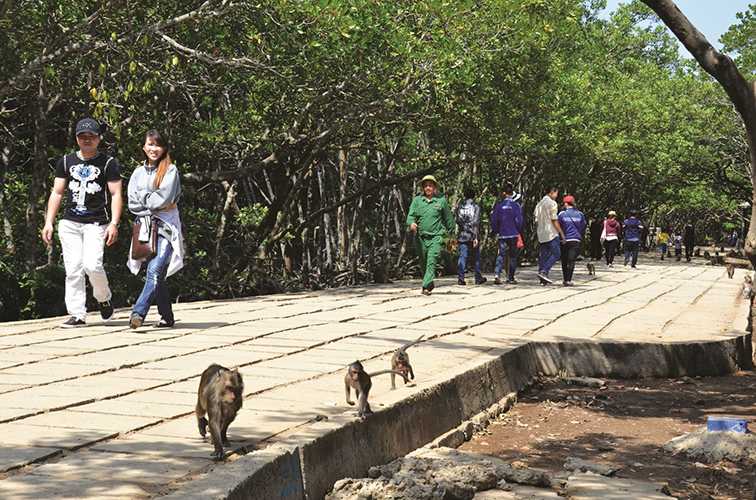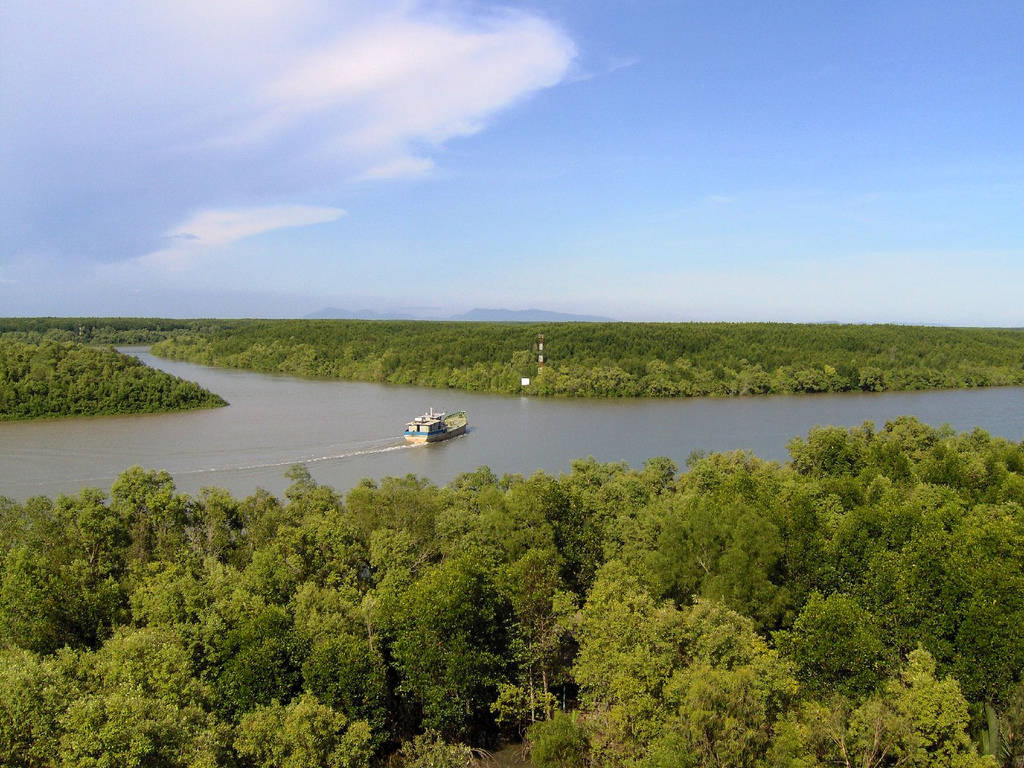

21/12/2017
Cần Giờ mangrove forest consists of terrestrial and aquatic forest fauna and flora, which was established in the downstream of the Đồng Nai - Sài Gòn river system, located in the Southeast direction/gateway of Hồ Chí Minh City, has an area of 75,740 ha, of which the core zone is 4,721 ha, buffer zone 41,139 ha and the transition zone of 29,880 ha. With diverse, typical and unique fauna and flora system, Cần Giờ mangrove forest plays important roles in preventing disasters, acting as a green lung to regulate the climate and a place to provide many valuable aquatic species of the South West region, recognized by UNESCO as the world’s biosphere reserve.
 |
|
Tourists will have more chance to experience ecotourism types in Cần Giờ mangrove forest |
In the past, Cần Giờ mangrove forest was very vast, and was also named as Sac forest (as Southern people call Avicennia as sac tree). This is a mangrove species growing with other species such as: sú (Aegiceras corniculatum) vẹt (Bruguiera), đước (Rhizophora) ô rô (Acanthus jịcifoiius L.) chà là (Phoenix dactylifera) to make a group of mangrove species. The pioneer sea invading species are appropriate with unstable muddy areas in accretion areas in coastal estuary. Avicennia and Rhizophara species grow first. When the mud is stable, and the water is less salty, the nypa grows finally in the sea invading army.
During 1962 - 1971, the American destroyed the Sac forest using herbicides; in addition, the widespread destruction of forests, forests were totally destroyed and turned into bare areas, vacant lands, and shrub lands. Many mangrove fauna species such as shrimp and fish also disappeared. In 1985, Cần Giờ people and the army determined to replant the forest. Ten thousands of ha of Sac forest regenerated. Up to now, 60 flora species have reappeared, mostly Rhizophora species. Tens of watery birds stay in the forest, including pelican, ibis, crane, heron, flamingo, and mallard.
After 30 years of rehabilitation, Sac forest now is called as Cần Giờ mangrove forest which has been rehabilitated in 30,491ha, the previous bare land has become a green forest, which create a beautiful landscape and an appropriate habitat for many flora and fauna species. Cần Giờ mangrove forest has been highly assessed by international experts on forest plantation, nursing and protection in Việt Nam as well as in the world. Forestry scientists have rehabilitated the ecosystem of Cần Giờ mangrove forest to its natural status which was awarded the Hồ Chí Minh Award in 2005.
 |
|
Cần Giờ mangrove forest is a green lung of Hồ Chí Minh City |
Cần Giờ mangrove forest is located in a very special geographical location with coastal wetland ecosystem; the mangrove forest is affected by the impacts of estuaries and the sea. Annually, the mangrove forest receives a high amount of sediments from Đồng Nai River together with the influence of the sea and tides which make the fauna and flora system here is very diverse. Trees in the forest have become food source and habitat for many aquatic species, fish and other vertebrate species.
Cần Giờ mangrove forest has 157 flora species belonging to 76 families, of which 35 mangrove tree species of 36 genus, 24 families. The invertebrate and aquatic fauna system consists of 70 species belonging to 44 families (mostly marine crab, tiger prawn, banana prawn, blood cockle…); the fish system consists of 137 species in 39 families (with different fish species: eeltail catfish, bông lau (Pangasius krempfi) dứa (Pangasius kunyit); the bird system consists of 130 species, 47 families, 17 orders (grey pelican, grey heron, night heron, adjutant, painted stork…) the mammal has 19 species, 13 families, 7 orders (wild cat, long tailed macaque, common palm civet, porcupine…) the amphibian and reptile system consists of 9 amphibian species and 31 reptile species (Asian water monitor, Chinese cobra, reticulated python, saltwater crocodile…) Particularly, 11 reptiles are in the Việt Nam Red list such as gecko, Asian water monitor, black tailed python, reticulated python, banded krait, Chinese cobra, king cobra, Pacific ridley sea turtle, and saltwater crocodile.
In addition, the forest consists of many tree species, mostly bần trắng (Sonneratia alba), mấm trắng (Avicennia alba blume), mixture of đước đôi (Rhizophora apiculate) - bần trắng (Sonneratia alba) and xu ổi (Xylocarpus granatum). Trees in brackish water consist of bần chua (Sonneralia caseolaris), ô rô (Acanthus jịcifoiius L.), nypa, ráng (Acrostichum aureum). Agricultural trees consist of rice, purple yam, and different types of bean, coconut, fruit trees. Cần Giờ mangrove forest is an ecotourism site, which bring considerable income for local people. Cần Giờ mangrove forest is also a laboratory which is used for scientific studies on this special ecosystem. Annually, hundreds of students of universities nationwide visit and choose it as research topics and receives many domestic and international scientists to study on the fauna and flora.
Currently, the land use planning is inappropriate such as sea invasion works for beaches and tourism, and the overexploitation of natural resources are threats to the ecosystems of Cần Giờ mangrove forest. Therefore, to support the local communities to protect the natural resources, support local people to have sustainable livelihoods, it’s foremost to finalize the policy mechanism on management and detailed planning of land resources, river channels, mangroves, fauna and flora, tourism sites, transportation… spatial identification - areas of core zones, buffer zones and transition zones for the purpose of biodiversity conservation and environmental protection in inland areas, river and sea. It is also important to mobilise the participation and contribution of relevant stakeholders to the planning, management and exploitation of resources, particularly of tourism service area.
Regularly implementing the propaganda and education on environmental protection and biodiversity, response to climate change and sea level rise. Studying community livelihoods for people living surrounding the buffer zone by surveying nearby people; training skills on community jobs, linking vocational training colleges on tourism and cooking with tourism companies to implement ecotourism services. Organizing community group to protect the forests, establishing protection units in key areas and in all sub-sites, effectively performing the forestry extension, and job creation and income for labourers through plantations.
Dương Liễu, Xuân Thăng